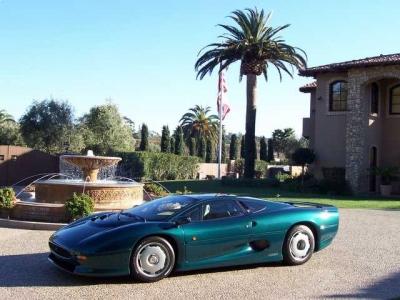SCM Analysis
Detailing
This 1993 Jaguar XJ 220 sold for $186,500 at the Bonhams & Butterfields auction in Carmel, CA, on August 19, 2005.
Was a louder groan ever heard within the automotive world than when the XJ 220 finally came to market? The hype surrounding this car was enormous, the letdown legendary.
The XJ 220 was developed rather unofficially through the after-hours efforts of Jaguar’s “Saturday Club,” a group of engineers dedicated to special projects within the Coventry confines. When chief engineer Jim Randle finally presented company executives with a plan they could commit to, the 1988 Birmingham Motor Show saw the unveiling of a stunning concept, and the response was overwhelming.
Moving forward, Jaguar had promised a twelve-cylinder, all-wheel drive wondercar, and there seemed no shortage of deep-pocketed customers waiting in the wings. With Tom Walkinshaw Racing tasked with developing the big V12, and FF Developments handling the complicated drive arrangement, the prospect of a Jag on par with the Ferrari F40s and Porsche 959s of the world was almost too much for enthusiasts and speculators to bear.
Promises and prospects are one thing, but the realities of advanced development made for an entirely different car. When it debuted in 1992, the V12 had been swapped for a TWR-developed twin-turbo V6, Jaguar’s first. Gone also was the all-wheel drive, in favor of the simpler and more conventional rear-drive layout. What remained was a bulky, lanky car with a buzzy, kazoo exhaust note and harsh turbo lag. Sorry, chaps.
It didn’t matter that the production XJ 220 boasted 542 hp or had a claimed top speed of 217 mph. For $625,000 (the auction company’s $700k seems somewhat optimistic to me), many buyers felt double-crossed and bailed, eating their hefty deposits in the process. Adding fuel to the flames was the 1990 worldwide crash of the collector car market.
As if all this weren’t enough, Walkinshaw had begun offering what the XJ 220 could not-a Jag V12-in the form of the ultra-low production XJR-15, which was closely based upon the Le Mans-winning XJR-9 of 1990.
In just a few short years, Jaguar’s lofty supercar proved to be the wrong car at the wrong time-in spades.
Amid the chaos and wrangle of legal battles-Irate Customer v. Jaguar; Jaguar v. Unfaithful Customer; etc.-finished cars went unsold for years, stacked in Coventry like Japanese businessmen sleeping in a Tokyo hotel. In the end, the XJ 220 couldn’t have been a bigger calamity for Jaguar.
Even the company’s racing pedigree was utterly discredited. For reasons still unknown, they took a Le Mans-winning formula and did the unthinkable, shipping a dozen or so cars to the U.S. (where they weren’t even legal to own) for the “Fast Masters” race series. Those involved soon dubbed it “Crash Masters,” as it was painfully obvious to anyone who watched that these behemoths weren’t meant for short-track ovals.
By most standards, the Jaguar XJ 220 simply failed to deliver what its designers, its financiers, and certainly its customers expected from it. It was the over-hyped athlete who let himself go, only to blow out his knees before the first game.
If there is a ray of sunshine in the XJ 220 tale, it is this: A dozen years after the fact, this car was well bought. The price paid, $186,500, is spot-on for an EPA/DOT released car with low miles. Only Sir Reg Dwight’s car (that’s Elton John to you and me), with its extensive tabloid documentation of his road cone “incident,” seems to do better, and that’s clearly due to the star connection.
So this buyer can feel safe in his purchase in terms of today’s value. And it’s likely to hold in this price range, a good buy when compared to a stock market whose daily gyrations make a Coney Island roller coaster look like a wagon ride. A casual check at Euro cars that still need to be imported shows asking prices (seven were readily available on one Web site) anywhere from $157,300 to $242,000, so they’re not difficult to find. Having the EPA/DOT releases in hand is a plus, as the federalization process can have its own surprises and time delays.
I only hope this luxo-bus was bought for use and not as an investment. Prices have been flat for years and with 281 of these dinosaurs roaming the planet (too many in my view, though they planned to build 350), the best use for this Jaguar XJ 220 is crisscrossing the country at high speed. If it goes fast enough, perhaps it might even slim down and lose some weight.
